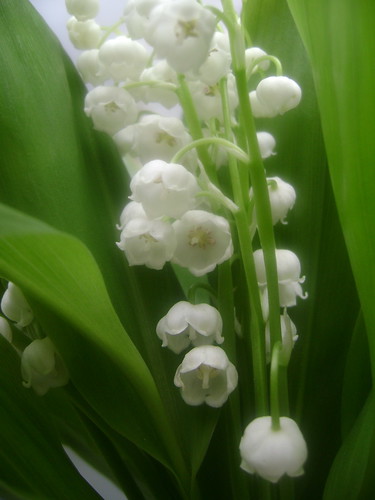Happy First of May!
I don't know what is it about lily of the valley that makes it smell so happy, but it does. It is a French tradition to offer lily of the valley to your loved ones on First of May (aka Labour Day) to wish them happiness. And if you received a stem with 13 bells, you are considered particularly lucky.
The little flower, convallaria majalis, has a modest appearance, reminiscent of bluebells that lost their colour. The bells point downwards in what could be considered as shyness or modesty (though I’m quite certain the flower have other reasons to behave that way).
It’s important to note that although bearing the same name, the lily of the valley (convallaria majalis) is certainly not the flower mentioned in the bible in Canticles (Song of Songs). The flower mentioned their is either wild hyacinth or some other kind of wild lily, perhaps what is called “Shoshan Tzahor” (literally translated as “white lily” in Hebrew). Lilies, as most bulb flowers, are rather rare in Israel and their beauty and rarity has served as a metaphor in the above mentioned poem. Later on, lily of the valley and other white lilies (namely the Madonna Lily) have become a symbol of purity and of the Virgin Mary in Christianity. But neither of these species can grow in Israel wild and most likely were not known or cultivated when the poem was written.
Bo Jensen’s website tells us that 2,3-Dihydrofarnesol, farnesol, citronellyl acetate, phenylacetonitrile and phenylacetaldehyde oxime are the main molecules discovered in lily of the valley headspace. 3,7-dimethyl-7-hydroxyoctanal or hydroxycitronellal were both discovered in the beginning of the century and I won’t be surprised if one or the other is used in Roudniska’s iconic lily of the valley Diorissimo and Coty’s Muguet de Bois (though they may be have both been modified to accommodate various regulations because both compounds are not particularly stable and can cause allergies, according to the same website).
The fresh flowers are so typically lily of the valley it’s amazing. I haven’t noticed as much variety between individual flowers as I find in other species (i.e.: roses). Besides the obvious “lily of the valley” smell there are also some lemony and green notes surrounding the flowers. They last in a vase for 2-3 days while retaining an impressive amount of the scent, but will never overpower the room like hyacinth or true lilies do.
If you live in the warmer parts of the world and can’t get the fragrant flowers from your florist, I suggest you find yourself a bottle of Diorissimo and scent your May Day with it. I just so happen to be wearing it as we speak.



